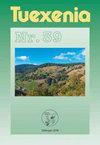瑞士汝拉中干草原40年来植被变化
IF 1.1
4区 生物学
Q3 PLANT SCIENCES
引用次数: 0
摘要
在上个世纪,中欧的中干旱草地急剧减少。这些物种丰富的栖息地受到农业利用的集约化或放弃、富营养化、气候变化和景观破碎化的威胁。然而,中欧不同地区的不同研究在变化程度和方向上的发现是不一致的。因此,我们重新调查了瑞士汝拉山脉联盟中色统的历史植被样地。在2020年,我们重新采样了28个1980年记录的准永久植被样地,以量化潜在的植被变化。分析了植物社会学联盟的物种个体频率、物种多样性、11个生态指标值和4个功能性状以及诊断种的存在情况。此外,还进行了生境分类和非趋势对应分析(DCA)。到2020年,物种丰富度、光效和温度指示值、动物种子传播和种子持久性显著下降。相反,养分有效性和土壤水分的生态指标值以及种子质量和冠层高度的群落加权平均值显著增加。2020年野生物种、应激恢复植物、植生植物和草本变色虫数量明显减少。相反,高度竞争的物种和半隐植物增加了。总之,这些发现表明,随着时间的推移,生产力会提高。与1980年相比,2020年的特殊物种较少,表明植被同质化,向营养丰富的牧场和草甸转移。向后期演替阶段的转变可能表明放牧干扰减少。这些地点大多数目前没有列入农业环境计划。我们的研究结果与中欧其他地方报告的部分差异突出了区域适应保护策略的重要性,以阻止中干旱草原的生物多样性丧失。本文章由计算机程序翻译,如有差异,请以英文原文为准。
Vegetation change in meso-xeric grasslands of the Swiss Jura Mts. over 40 years
Meso-xeric grasslands have declined sharply in Central Europe during the last century. These species-rich habitats are threatened by intensification or abandonment of agricultural use, eutrophication, climate change and landscape fragmentation. However, different studies in various regions of Central Europe are inconsistent in their findings about degree and direction of changes. We thus resurveyed the historical vegetation plots of the alliance Mesobromion in the Swiss Jura Mts. In 2020, we re-sampled 28 quasi-permanent vegetation plots originally recorded in 1980 to quantify potential vegetation change. Frequency of individual species, species diversity, 11 ecological indicator values and four functional traits, as well as the presence of diagnostic species of phytosociological alliances, were analysed. Further, a habitat classification and detrended correspondence analysis (DCA) were also performed. Species richness, indicator values for light availability and temperature, seed dispersal by animals and seed persistence had significantly decreased by 2020. Conversely, ecological indicator values for nutrient availability and soil moisture as well as community-weighted means for seed mass and canopy height had significantly increased. There were significantly fewer ruderal species, stresstolerators, therophytes and herbaceous chamaephytes in 2020. In contrast, highly competitive species and hemicryptophytes had increased. Together, these findings indicate an increase in productivity over time. There were fewer specialized species in 2020 than in 1980, indicating a homogenization of the vegetation and a shift towards nutrient-rich pastures and meadows. The shift towards a later successional stage might indicate reduced grazing disturbance. Most of these sites are currently not included in an agri-environmental scheme. Partial differences of our findings from those reported elsewhere in Central Europe highlight the importance of regionally adapted conservation strategies in order to stop biodiversity loss in meso-xeric grasslands.
求助全文
通过发布文献求助,成功后即可免费获取论文全文。
去求助
来源期刊

Tuexenia
PLANT SCIENCES-
CiteScore
2.80
自引率
25.00%
发文量
0
期刊介绍:
Tuexenia publiziert Original- und Übersichtsarbeiten sowie Berichte zu Themen der Geobotanik / Vegetationsökologie und zu Nachbarwissenschaften wie Populationsökologie, Biodiversitätsforschung, Biozönologie, Renaturierungsökologie und ihren Anwendungen, vor allem im Naturschutz. Der geografische Schwerpunkt liegt in Zentraleuropa und angrenzenden Regionen.Tuexenia erscheint jährlich in einem Band, der etwa zur Jahresmitte fertig gestellt wird. Autoren erhalten von jeder Arbeit eine PDF-Datei und gemeinsam 20 Sonderdrucke kostenlos.
Die Qualität der wissenschaftlichen Manuskripte wird durch die Redaktion und einen Wissenschaftlichen Beirat (Peer Review) gesichert (s. auch die Manuskript-Richtlinien vor dieser Seite). Es werden keine Druckkosten erhoben. Tuexenia legt Wert auf allgemeine Online-Verfügbarkeit der Beiträge.
 求助内容:
求助内容: 应助结果提醒方式:
应助结果提醒方式:


